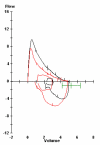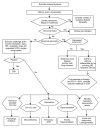Imitators of exercise-induced bronchoconstriction
- PMID: 20016690
- PMCID: PMC2794850
- DOI: 10.1186/1710-1492-5-7
Imitators of exercise-induced bronchoconstriction
Abstract
Exercise-induced bronchoconstriction (EIB) is described by transient narrowing of the airways after exercise. It occurs in approximately 10% of the general population, while athletes may show a higher prevalence, especially in cold weather and ice rink athletes. Diagnosis of EIB is often made on the basis of self-reported symptoms without objective lung function tests, however, the presence of EIB can not be accurately determined on the basis of symptoms and may be under-, over-, or misdiagnosed. The goal of this review is to describe other clinical entities that mimic asthma or EIB symptoms and can be confused with EIB.
Figures
Similar articles
-
Cold air exercise screening for exercise induced bronchoconstriction in cold weather athletes.Respir Physiol Neurobiol. 2019 Nov;269:103262. doi: 10.1016/j.resp.2019.103262. Epub 2019 Jul 29. Respir Physiol Neurobiol. 2019. PMID: 31369875
-
Perception of Exercise-Induced Bronchoconstriction in College Athletes.Respir Care. 2016 Jul;61(7):897-901. doi: 10.4187/respcare.04553. Epub 2016 Mar 22. Respir Care. 2016. PMID: 27006350
-
Baseline lung function, exercise-induced bronchoconstriction, and asthma-like symptoms in elite women ice hockey players.Med Sci Sports Exerc. 2004 Mar;36(3):405-10. doi: 10.1249/01.mss.0000117118.77267.bf. Med Sci Sports Exerc. 2004. PMID: 15076781
-
Sex Differences in Exercise-Induced Bronchoconstriction in Athletes: A Systematic Review and Meta-Analysis.Int J Environ Res Public Health. 2020 Oct 5;17(19):7270. doi: 10.3390/ijerph17197270. Int J Environ Res Public Health. 2020. PMID: 33027929 Free PMC article.
-
The inflammatory basis of exercise-induced bronchoconstriction.Phys Sportsmed. 2010 Dec;38(4):67-73. doi: 10.3810/psm.2010.12.1827. Phys Sportsmed. 2010. PMID: 21150144 Review.
Cited by
-
Heredity of supraglottic exercise-induced laryngeal obstruction.Eur Respir J. 2017 Aug 17;50(2):1700423. doi: 10.1183/13993003.00423-2017. Print 2017 Aug. Eur Respir J. 2017. PMID: 28818875 No abstract available.
-
Exercise-Induced Bronchoconstriction in Children: State of the Art from Diagnosis to Treatment.J Clin Med. 2024 Aug 5;13(15):4558. doi: 10.3390/jcm13154558. J Clin Med. 2024. PMID: 39124824 Free PMC article. Review.
-
Prevalence of exercise-induced bronchoconstriction and laryngeal obstruction in adolescent athletes.Pediatr Pulmonol. 2020 Dec;55(12):3509-3516. doi: 10.1002/ppul.25104. Epub 2020 Oct 20. Pediatr Pulmonol. 2020. PMID: 33002318 Free PMC article.
-
The Need for Testing-The Exercise Challenge Test to Disentangle Causes of Childhood Exertional Dyspnea.Front Pediatr. 2022 Jan 6;9:773794. doi: 10.3389/fped.2021.773794. eCollection 2021. Front Pediatr. 2022. PMID: 35071131 Free PMC article.
-
Immunity, Inflammation and Airway Dysfunction in Elite Cross-Country Skiers and Ice Hockey Players: A Systematic Review.Scand J Med Sci Sports. 2025 Apr;35(4):e70046. doi: 10.1111/sms.70046. Scand J Med Sci Sports. 2025. PMID: 40223161 Free PMC article.
References
-
- Anderson SD, McEvoy JD, Bianco S. Changes in lung volumes and airway resistance after exercise in asthmatic subjects. Am Rev Respir Dis. 1972;106:30–7. - PubMed
-
- McFadden ER Jr, Nelson JA, Skowronski ME, Lenner KA. Thermally induced asthma and airway drying. Am J Respir Crit Care Med. 1999;160:221–6. - PubMed
LinkOut - more resources
Full Text Sources



